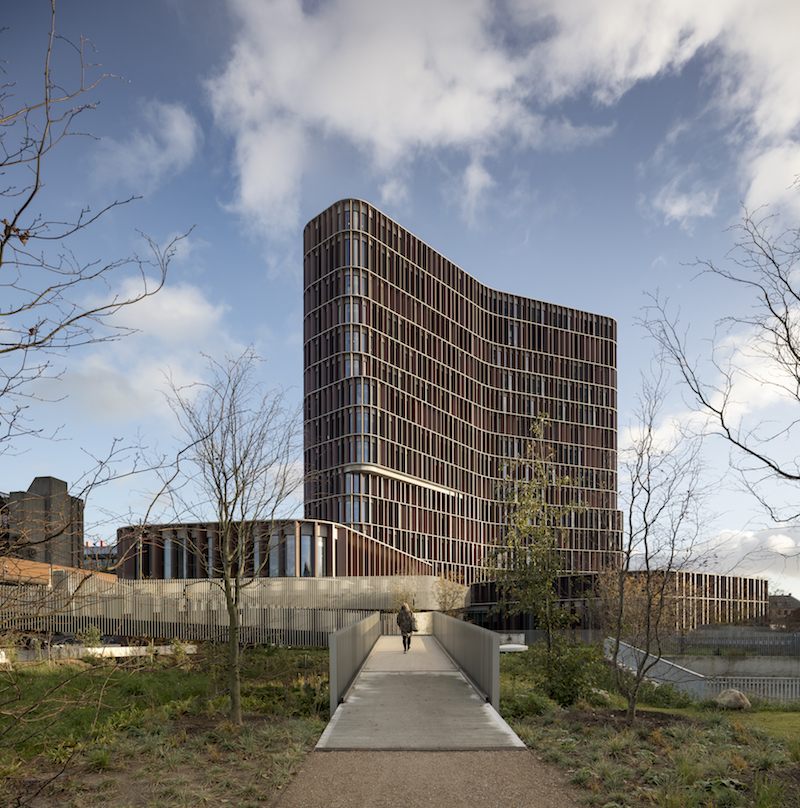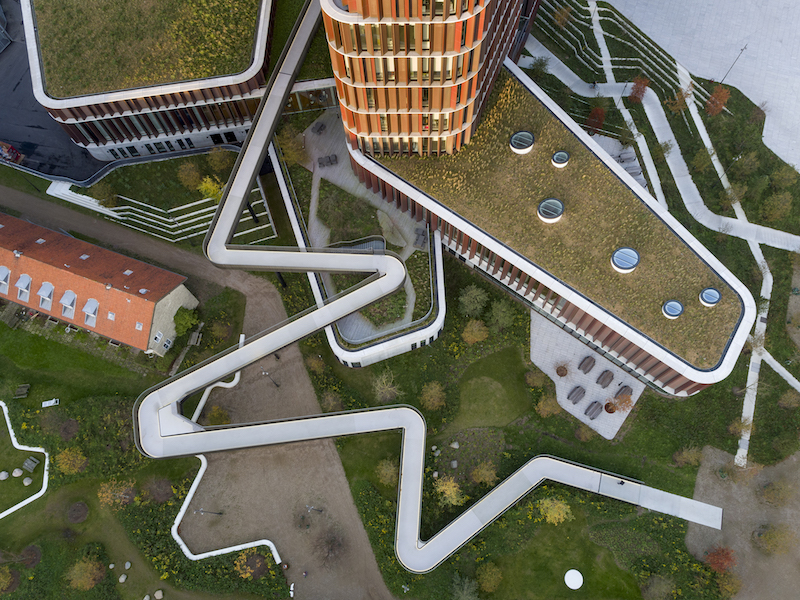Maersk Tower is a new 42,700-sm research building designed and built as an extension of Panum, the University of Copenhagen’s Faculty of Health Sciences. The new building includes research and teaching facilities and a conference center with auditoriums and meeting rooms.
The tower rests on a low base that comprises all common facilities. The base is publicly accessible and appears open and in close dialogue with the surrounding environment thanks to its glass façade. The research functions and laboratories are located in the tower itself and are bound to each other in a loop that provides short distances between locations and improves the possibility of collaboration.
 Photo: Adam Mørk.
Photo: Adam Mørk.
An open atrium and a spiral stairway visually and physically connects each of the building’s fifteen floors. A “Forskertorv” exists around the staircase and creates a natural meeting place and community room for the building’s users.
Maersk Tower’s exterior façade is divided into a grid structure of floor-high copper-plated shutters. The shutters act as a climate guard that moves and shields direct sunlight and overheating. The shutters also help to break down the tower’s large scale. Adding to the energy efficiency of the building, the laboratories capture waste energy and reuse it for other purposes.
 Photo: Adam Mørk.
Photo: Adam Mørk.
Surrounding the tower is a publicly available urban campus park equipped with a “floating trail” that leads pedestrians and cyclists across part of Maersk Tower and creates a new connection between Nørre Allé and Blegdamsvej.
 Photo: Adam Mørk.
Photo: Adam Mørk.
Related Stories
| Jun 9, 2014
6 design strategies for integrating living and learning on campus
Higher education is rapidly evolving. As we use planning and design to help our clients navigate major shifts in culture, technology, and funding, it is essential to focus on strategies that help foster an education that is relevant after graduation. One way to promote relevance is to strengthen the bond between academic disciplines and the campus residential life experience.
| May 29, 2014
7 cost-effective ways to make U.S. infrastructure more resilient
Moving critical elements to higher ground and designing for longer lifespans are just some of the ways cities and governments can make infrastructure more resilient to natural disasters and climate change, writes Richard Cavallaro, President of Skanska USA Civil.
Sponsored | | May 27, 2014
Grim Hall opens the door to fire safety with fire-rated ceramic glass
For the renovation of Lincoln University’s Grim Hall life sciences building into a state-of-the-art computer facility, Tevebaugh Associates worked to provide students and faculty with improved life safety protection. Updating the 1925-era facility's fire-rated doors was an important component of the project.
| May 20, 2014
Kinetic Architecture: New book explores innovations in active façades
The book, co-authored by Arup's Russell Fortmeyer, illustrates the various ways architects, consultants, and engineers approach energy and comfort by manipulating air, water, and light through the layers of passive and active building envelope systems.
| May 19, 2014
What can architects learn from nature’s 3.8 billion years of experience?
In a new report, HOK and Biomimicry 3.8 partnered to study how lessons from the temperate broadleaf forest biome, which houses many of the world’s largest population centers, can inform the design of the built environment.
| May 13, 2014
19 industry groups team to promote resilient planning and building materials
The industry associations, with more than 700,000 members generating almost $1 trillion in GDP, have issued a joint statement on resilience, pushing design and building solutions for disaster mitigation.
| May 11, 2014
Final call for entries: 2014 Giants 300 survey
BD+C's 2014 Giants 300 survey forms are due Wednesday, May 21. Survey results will be published in our July 2014 issue. The annual Giants 300 Report ranks the top AEC firms in commercial construction, by revenue.
| May 10, 2014
How your firm can gain an edge on university projects
Top administrators from five major universities describe how they are optimizing value on capital expenditures, financing, and design trends—and how their AEC partners can better serve them and other academic clients.
| May 1, 2014
First look: Cal State San Marcos's posh student union complex
The new 89,000-sf University Student Union at CSUSM features a massive, open-air amphitheater, student activity center with a game lounge, rooftop garden and patio, and ballroom space.
| Apr 29, 2014
USGBC launches real-time green building data dashboard
The online data visualization resource highlights green building data for each state and Washington, D.C.

















